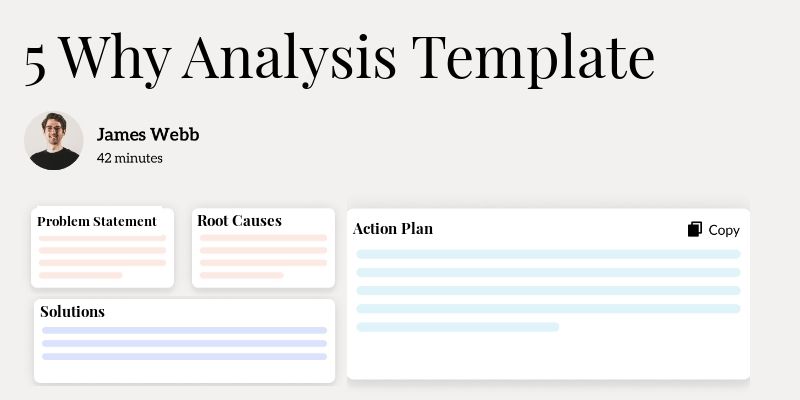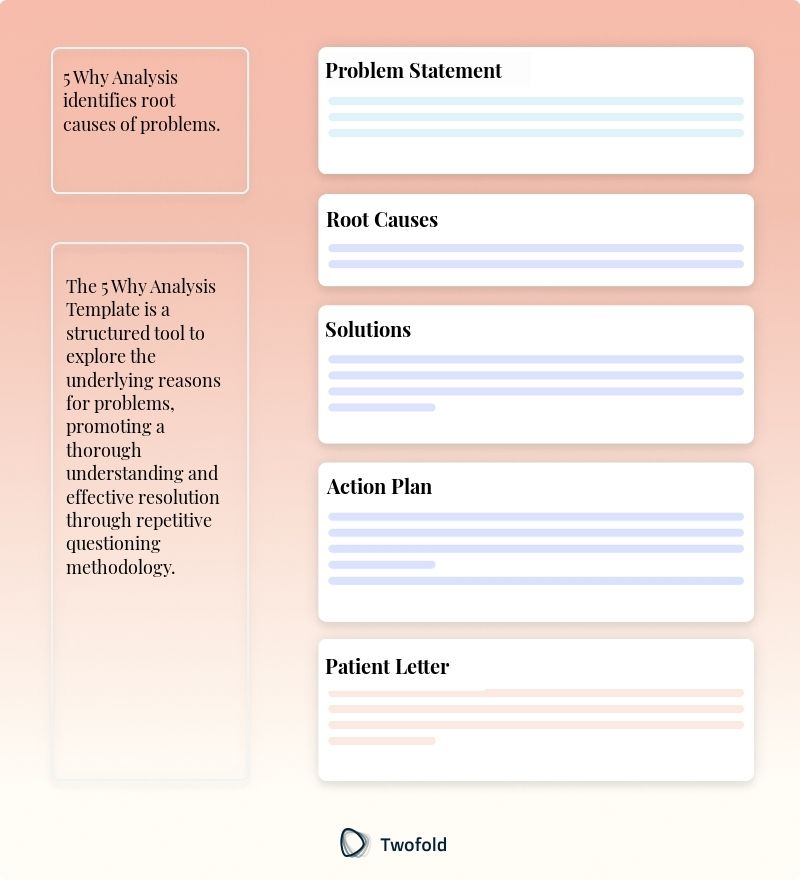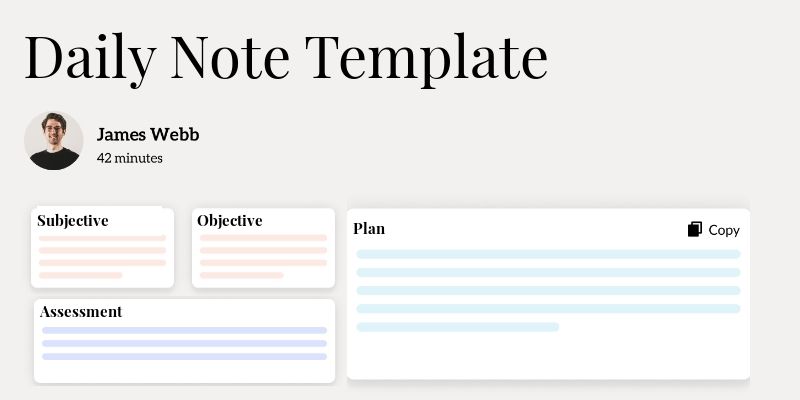
5 Why Analysis Template
Sometimes, problem analysis can feel like an uphill battle. Whether in healthcare or any other industry, getting to the root cause of a persistent problem can be frustrating. Fortunately, the 5 Why Analysis Template offers a structured way to drill down into recurring issues. Wondering how this powerful tool could simplify your problem‑solving approach? Stick around, and let's break it down.
What Is a 5 Why Analysis Template?
The 5 Why Analysis Template is a systematic method used to delve into the causes of a particular problem. Essentially, it employs a series of "why" questions to peel back the layers of causes, starting from a specific problem to its root cause.
This template is particularly handy in medical settings, where understanding the root causes of errors or inefficiencies can lead to better patient outcomes and smoother operations. It's straightforward yet amazingly effective at guiding teams through complex issues.
Key Components of a 5 Why Analysis
While the process might seem simple, certain components are essential to make the analysis effective:
- Problem Statement: Clearly articulated issue that needs resolution.
- Sequential "Why?" Questions: Each answer leads to the next question.
- Answers Documentation: Record each layer of responses.
- Corrective Actions: Suggestions based on root cause analysis.
- Verification and Validation: Confirming the root cause and the effectiveness of actions.

How to Use a 5 Why Analysis Template: Step-by-Step Process
Step 1: Define the Problem
Begin by clearly stating the problem. It should be specific and measurable.
Step 2: Ask the First "Why?"
Pose the first "why" question related to the problem and record the answer.
Step 3: Continue with Subsequent "Why?" Questions
Use the answer from each "why" to form the next question, digging deeper through at least five levels.
Step 4: Identify the Root Cause
Once the true root cause is identified, document it accurately.
Step 5: Establish Corrective Actions
Based on the insights gained, outline actionable measures to address the root cause.
Benefits of a 5 Why Analysis
Benefit | Description |
|---|---|
In-depth Understanding | Promotes deeper insights into the core of issues by structured questioning. |
Efficiency | Streamlines problem-solving processes by quickly narrowing down root causes. |
Collaboration | Fosters teamwork and diverse input, leading to more comprehensive solutions. |
Preventative Measures | Helps in formulating strategies that prevent recurrence of issues. |
Stakeholders in 5 Why Analysis
Various stakeholders contribute to an effective 5 Why Analysis process:
- Quality Assurance Teams: For example, QA teams can uncover systemic errors impacting healthcare efficiency.
- Medical Staff: Doctors and nurses can offer valuable clinical insights when analyzing treatment errors.
- Patient Safety Officers: By participating, they ensure safety protocols address underlying deficiencies in patient care.
- Administrative Personnel: These individuals often provide a broader organizational perspective, such as policy impacts.
Example of a 5 Why Analysis PDF
Understanding this template in practice can be enhanced by reviewing a real‑world PDF example.
Real-World Use Cases: Practical Impact of the 5 Why Template
The 5 Why Analysis Template has proven beneficial across numerous scenarios:
- In a hospital, a committee used this template to reduce medication errors, revealing that disruptions during drug administration were the root cause.
- A nursing home employed the template to investigate frequent falls, discovering that improper footwear policy was contributing to the injuries.
- In a clinic, the template helped address patient wait times by identifying understaffed registration desks as the primary issue.
- When evaluating supply shortages, a health center's use of the template unearthed inefficiencies in ordering processes, leading to a revamp for better supply chain management.
Conclusion
The 5 Why Analysis Template stands as a powerful tool in uncovering deep‑rooted issues in healthcare settings. With its structured yet straightforward approach, organizations can not only address immediate problems but also prevent their recurrence. By employing the tips, components, and steps discussed, professionals can leverage this method effectively to improve operations and patient outcomes.
Disclaimer: This article is for informational purposes only and does not constitute legal or medical advice. Always consult professional guidelines and regulatory bodies for specific compliance requirements.

Dr. Danni Steimberg
Dr. Danni Steimberg is a pediatrician at Schneider Children’s Medical Center with extensive experience in patient care, medical education, and healthcare innovation. He earned his MD from Semmelweis University and has worked at Kaplan Medical Center and Sheba Medical Center.
A 5‑Why worksheet shines when each “why” climbs logically to a fixable root cause. The WHY‑WISE ladder—What happened, Hard data, Yielding links, Workable root, Immediate containment, Sustainable countermeasure, Evidence check—turns a simple form into an audit‑ready problem‑solver.
- Anchor in Hard Data: Start every “why” with a measurable fact (“Machine X stopped at 14:32 due to belt failure”) so each step stays objective and verifiable.
- Yield a Workable Root: Stop climbing only when the answer points to a process you can control (e.g., missed maintenance schedule), not a vague human error.
- Seal with Evidence & Sustainability: Finish by listing the containment fix applied today and the long-term countermeasure plus how you’ll verify success—this closes the loop and satisfies quality auditors.
Ask ChatGPT
Frequently Asked Questions
Reduce burnout,
improve patient care.
Join thousands of clinicians already using AI to become more efficient.

Therapy Progress Report Template
Discover practical Therapy Progress Report templates to enhance your documentation efficiency.

Case Notes Template
Discover practical Case Notes templates to enhance your documentation efficiency.

Daily Note Template
Discover practical Daily Note Template templates to enhance your documentation efficiency.

